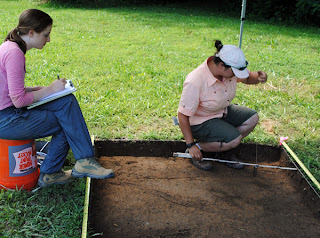.jpg) |
| Site A overall with Crystal facing west |
We just finished up the 2012 field school at French’s Tavern
at the larger Indian Camp site. The purpose of the field work was to locate a
quartering site dating from 1730-1777, the period of ownership of Francis
Eppes, then John Wayles, and then Thomas Jefferson.
44PO158 covers an area of about 85 ft. x 125 ft. that is
located at a field edge and extends into the adjacent forest. This field season,
we laid out 10 5 ft. x 5 ft. units along the field edge in two rows in a
checkerboard pattern in hopes of locating features associated with a possible
slave quarter.
In the far southwest
unit we found a large feature extending out of the northwest corner of the
unit. We opened up another unit along the northern wall and the feature
continued into that unit. It appeared to form to corner of a larger square or
rectangle. We mapped the portion of the feature that was exposed and cored it
with a small diameter coring tool. The soil contained within the core was
uniformly silty from top to bottom, indicating that the feature contains a
single layer of fill that probably represents sediment deposited from heavy
rain. The core results suggest that the feature may be a tree-fall or other
natural depression.
 |
| Katherine and Lauren mapping at Site A |
In the other excavation units, we have found many artifacts
that could relate to the target time period, but are not precisely dateable.
For example, we’ve found many brick fragments, pieces of charcoal, fragments of
dark green wine bottle glass, and hand wrought nails or fragments. We have also
found sizeable pieces of iron that we have not yet identified.
The ceramics from the site are more dateable. Two types were
made and used within our period of interest: English brown stoneware and creamware.
The greatest concentration of these ceramics is on the eastern side of the
northern line of units, closest to the forest edge. Fragments of Chinese
porcelain may also date to this period, or may be later. Pearlware sherds,
which date after 1780, have also been found at the site.
 |
| Large feature at 44PO158 |
A quick look at the spatial distribution of these artifacts
may indicate that we are excavating at the edge of a site located slightly
farther to the north, in the woods. Due to plowing, drainage and erosion, some
of the artifacts may have moved down slope from the east, west, or south due to
the sloping landscape of the site.
Further work relating to the site will include analyzing artifacts and samples in the lab.
Written by: Kathryn Gard
No comments:
Post a Comment